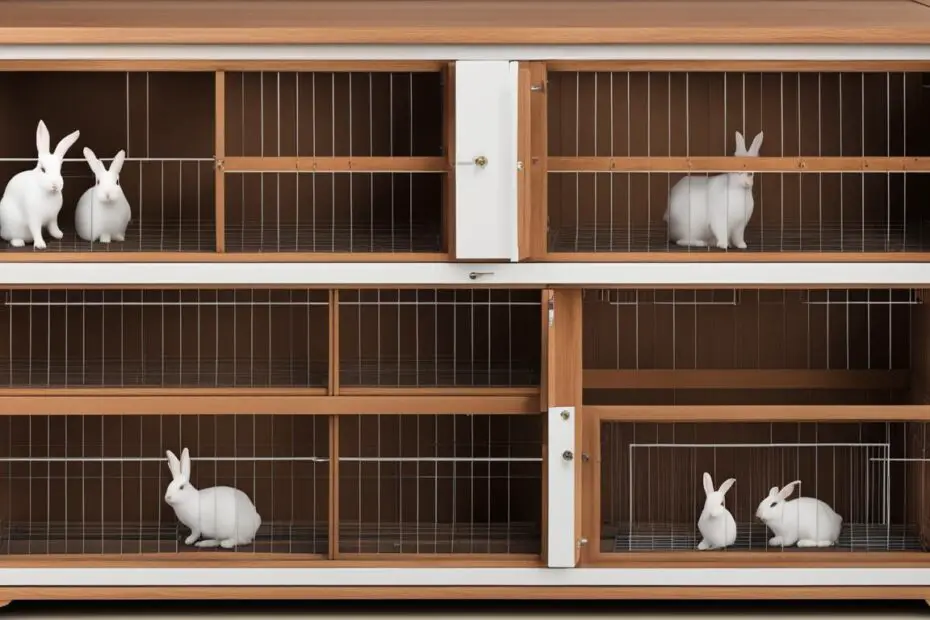When it comes to providing a comfortable and ideal living space for your rabbits, determining the right cage size is essential. Rabbit behavior can be influenced by the size of their enclosure, affecting their overall well-being. By optimizing the hutch space with a rabbit cage size calculator, you can ensure that your furry friends have the perfect environment to thrive in.
Studies have shown that decreasing the size of the rabbit cage may have limited effects on their behavior, with sternal lying being the most consistently affected. However, providing rabbits with more space during grooming can have a positive impact on their welfare. Additionally, incorporating wooden enrichment structures can decrease cage manipulation and improve their overall welfare.
Key Takeaways:
- Optimizing the hutch space with a rabbit cage size calculator is crucial for creating an ideal living space for your rabbits.
- Consider providing rabbits with more space during grooming to improve their welfare.
- Using wooden enrichment structures can decrease cage manipulation and improve overall welfare.
- Proper rabbit cage size is essential for the comfort and well-being of your furry friends.
- Utilize a rabbit cage size calculator to ensure you are meeting the requirements for an ideal rabbit cage size.
Factors to Consider in Rabbit Housing
When choosing a housing option for rabbits, it’s essential to consider factors such as indoor vs. outdoor settings and the climate in which they will be housed. Rabbits are most comfortable between 50 and 69 degrees Fahrenheit but can tolerate temperatures well below freezing and above 100 degrees if the cages are optimized for optimal conditions. In hot climates, good airflow and shading are crucial to keep rabbits cool, while in cold climates, protection from harsh elements should be provided. Regardless of the type of housing, it is essential to provide a layer of protection from predators and the elements.
Creating a comfortable and suitable environment for your pet rabbits involves considering various factors, such as their living space, temperature regulation, and protection from predators and harsh weather conditions. The recommended rabbit cage size can vary depending on whether you choose to house them indoors or outdoors. Rabbits are most comfortable in temperatures between 50 and 69 degrees Fahrenheit, but with proper optimization, they can tolerate even lower or higher temperatures.
In hot climates, good airflow and shading are crucial to keep rabbits cool and prevent them from overheating. This can be achieved by providing proper ventilation in the cage or enclosure and ensuring there are shaded areas for the rabbits to seek relief from the sun. Additionally, using materials that do not retain heat, such as wire mesh or perforated materials, can help in maintaining a comfortable environment.
On the other hand, in cold climates, it’s important to provide protection from harsh elements. This can be done by using insulation materials or providing sheltered areas within the enclosure where the rabbits can retreat to during extreme weather conditions. Ensuring that the rabbits have access to dry bedding and a draft-free area is crucial for their comfort and well-being.
No matter the housing choice, it is essential to incorporate measures to protect rabbits from predators. This can be achieved by using sturdy materials for the cage or enclosure, such as wire mesh with small openings, to prevent access from predators like foxes or raccoons. Additionally, ensuring that the cage or enclosure is securely built and has a proper lock mechanism will help keep the rabbits safe.
To summarize, when considering rabbit housing, it’s important to take into account indoor vs. outdoor settings, temperature regulation, and protection from predators and harsh weather conditions. Providing a secure, comfortable, and suitable environment will contribute to the overall well-being and happiness of your rabbits.
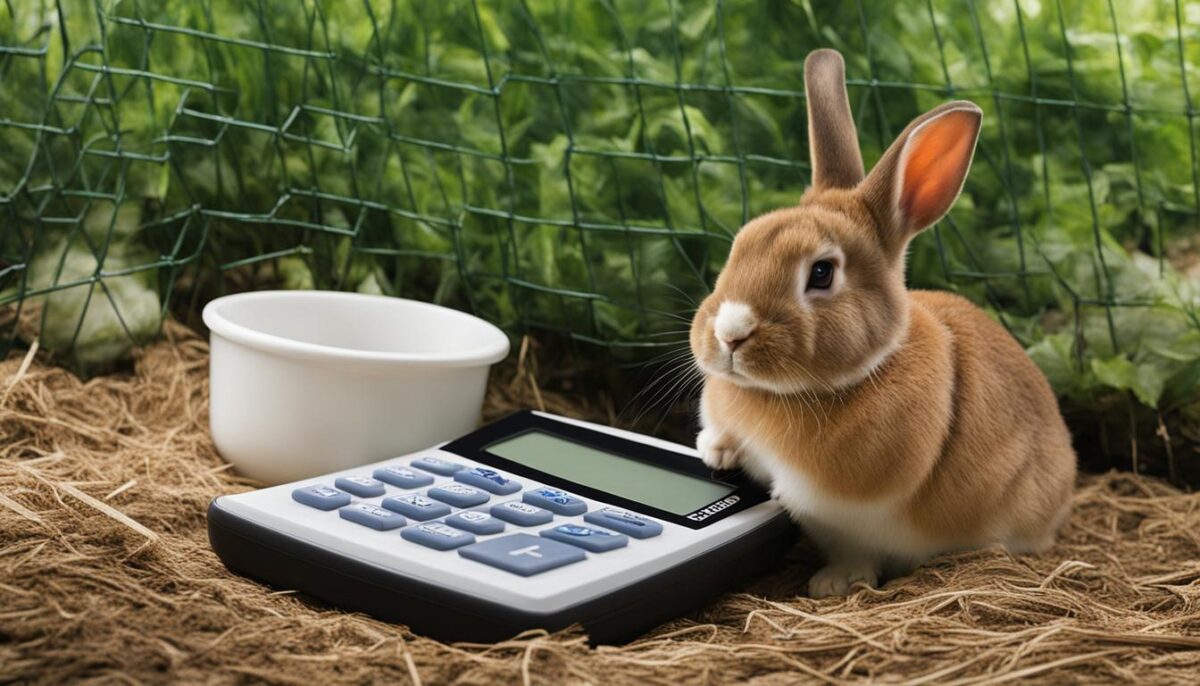
Building a Wire Rabbit Cage
Wire rabbit cages are a popular choice for housing rabbits due to their durability and resistance to chewing. When constructing a wire cage, it’s important to consider the appropriate gauge wire to ensure the comfort and safety of your rabbits. Additionally, calculating the dimensions of the cage is crucial to provide enough space for the rabbits to move around comfortably.
Choosing the Right Wire Gauge
When building a wire rabbit cage, it’s important to use the correct wire gauge to prevent sores on the rabbit’s feet. The most commonly used wire gauge for rabbit cages is 14-gauge wire. This gauge of wire provides sufficient strength and durability for the cage while ensuring the safety of your rabbits.
Selecting the Mesh Size
The mesh size of the wire cage is also an important consideration. For the sides and tops of the cage, a 1-by-2-inch mesh size is commonly used. This size allows for adequate airflow and visibility for the rabbits inside the cage. However, for the floor of the cage, a smaller mesh size should be used to protect the rabbit’s feet. This smaller size mesh prevents the rabbits from getting their feet caught or injured.
Ensuring Stability with Assembly
Assembling the wire cage properly is essential to ensure stability and security. J-clips or C-rings should be used to fasten the wire mesh together every few inches. This creates a strong and secure structure for the rabbit cage. Additionally, reinforcing the corners and edges of the cage with additional clips or rings can further enhance stability.
| Component | Recommended Specifications |
|---|---|
| Sides and Tops | 14-gauge wire woven in a 1-by-2-inch mesh |
| Floor | Smaller mesh size for the protection of rabbit’s feet |
| Assembly | J-clips or C-rings every few inches for stability |
Additional Considerations
When building a wire rabbit cage, it’s important to ensure the cage provides adequate space for the rabbits to move around, stretch, and exercise. Using a rabbit hutch size calculator can help determine the appropriate dimensions based on the number and size of rabbits being housed. Providing enough space is essential for the rabbits’ physical and mental well-being.
Furthermore, incorporating additional features such as platforms, ramps, and hiding spots can add enrichment and stimulation to the rabbit’s environment. These features encourage natural behaviors and provide mental stimulation for the rabbits.
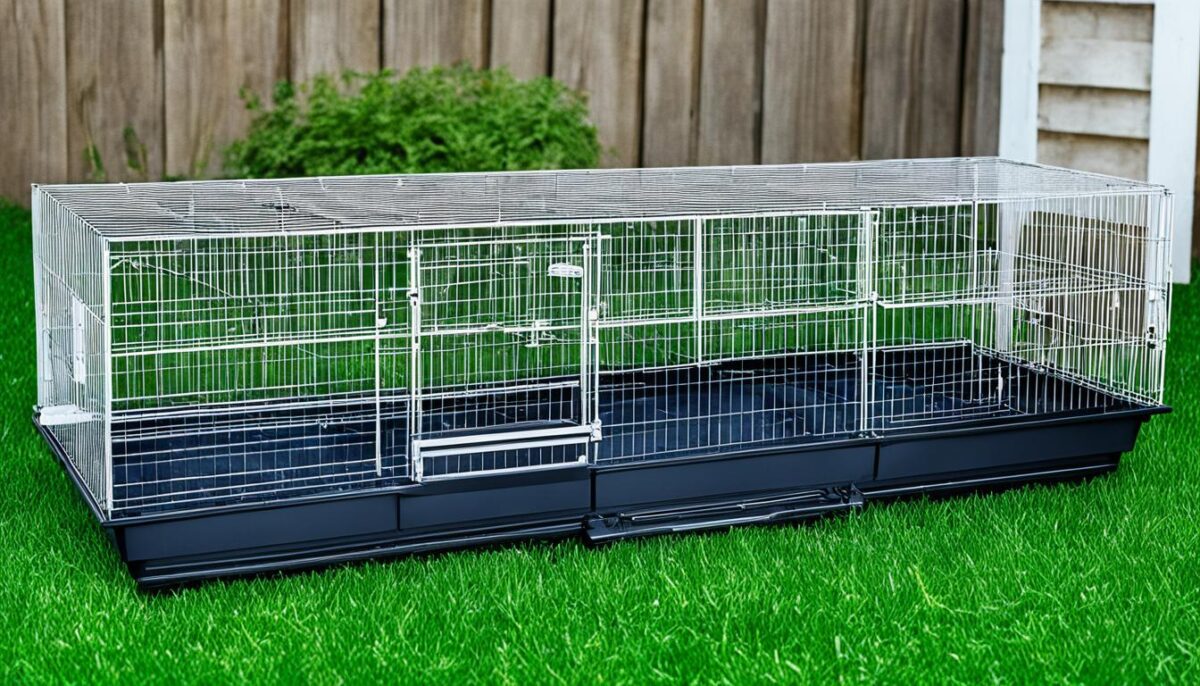
Building a wire rabbit cage allows you to create a durable and secure housing option for your rabbits. By choosing the right wire gauge, mesh size, and ensuring proper assembly, you can provide a comfortable and safe living space for your furry friends.
Designing an Outdoor Hutch Frame
When it comes to outdoor rabbit housing, a hutch frame offers additional protection against the elements and predators. To construct a sturdy hutch frame, you’ll need 2-by-4 lumber and plywood.
The key considerations for designing an outdoor hutch frame include:
- Well-ventilation and lighting: Ensure that the hutch has proper airflow to keep the rabbits comfortable and healthy. Adding removable sides can offer extra ventilation during the summer and protection during the winter. The hutch should also have adequate lighting for the rabbits’ well-being.
- Cleaning, feeding, and watering: Design the hutch frame with easy access points for cleaning, feeding, and watering the rabbits. This will simplify your daily care routine and maintain the rabbits’ hygiene.
- Indoor and outdoor adaptability: Consider the flexibility of your hutch frame design. It should be easily adaptable for both indoor and outdoor use, providing the rabbits with suitable housing in various environments.
Take a look at the following example of an outdoor hutch frame design:
| Design Features | Description |
|---|---|
| Material | 2-by-4 lumber and plywood |
| Ventilation | Removable sides for added air circulation |
| Lighting | Properly lit interior |
| Access | Easy cleaning, feeding, and watering points |
| Adaptability | Suitable for both indoor and outdoor use |
Visualize the potential outdoor hutch frame design:
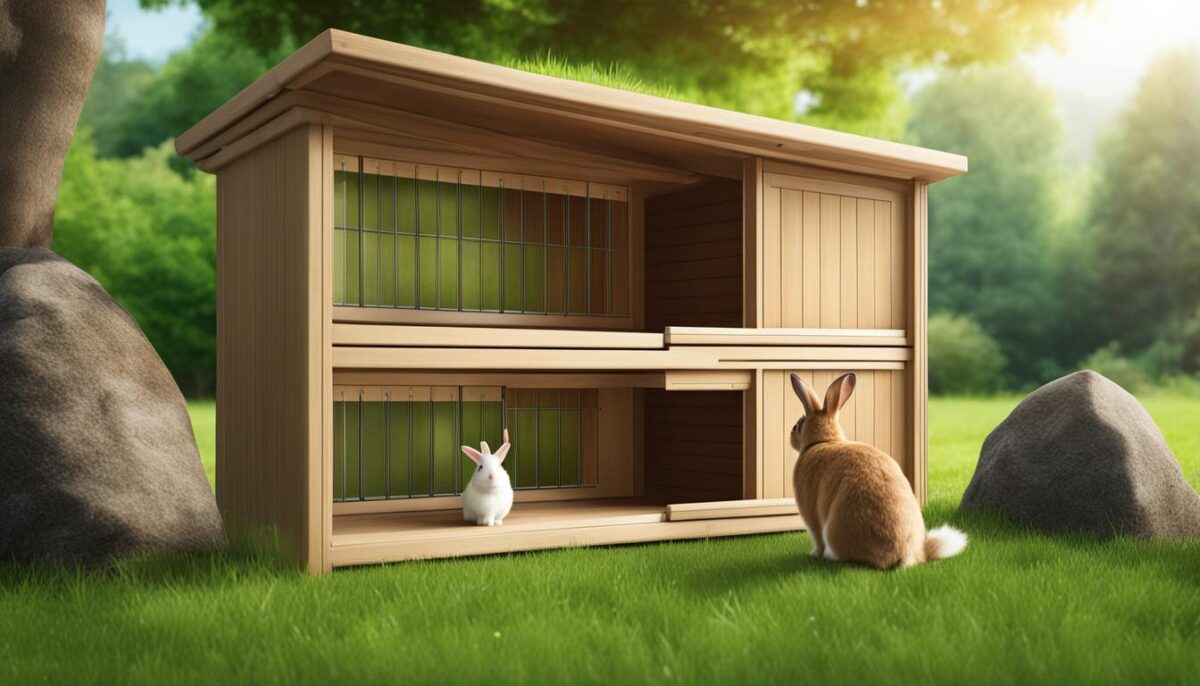
With a well-designed hutch frame, you can provide your rabbits with a safe and comfortable outdoor living space. It’s essential to prioritize the rabbits’ needs for ventilation, lighting, and access while ensuring adaptability to different environments.
Creating a DIY Rabbit Cage Rack
Making a rack to hold multiple rabbit cages can be an efficient use of space. PVC pipes are a cost-effective option for constructing the rack. The rack should be designed to accommodate the size of the cages and provide proper support. Using metal angles attached to the rack can allow for easy cleaning by allowing the dropping pans to slide out. It’s important to ensure the rack is stable and securely assembled to prevent any accidents.
Benefits of a DIY Rabbit Cage Rack
“A DIY rabbit cage rack offers several advantages for rabbit owners. Not only does it maximize space utilization, but it also provides a sturdy and organized setup for housing multiple rabbits. The use of PVC pipes as the primary material makes it affordable and easily customizable to fit individual needs and preferences.”
When creating a DIY rabbit cage rack, it’s essential to consider the following steps:
- Measure the dimensions of your rabbit cages to determine the appropriate size for the rack.
- Acquire PVC pipes in the required length and diameter. These can be easily found at most home improvement stores.
- Use PVC connectors, such as elbows and tees, to join the pipes together and create the desired rack structure.
- Ensure that the rack is stable by securely attaching all connections and reinforcing key joints if necessary.
- Place the rabbit cages on the rack, making sure they fit snugly and are supported evenly.
By following these steps, you can create a functional and space-saving rack for your rabbit cages. This DIY solution allows for efficient management of multiple rabbits while maintaining a clean and organized living space.
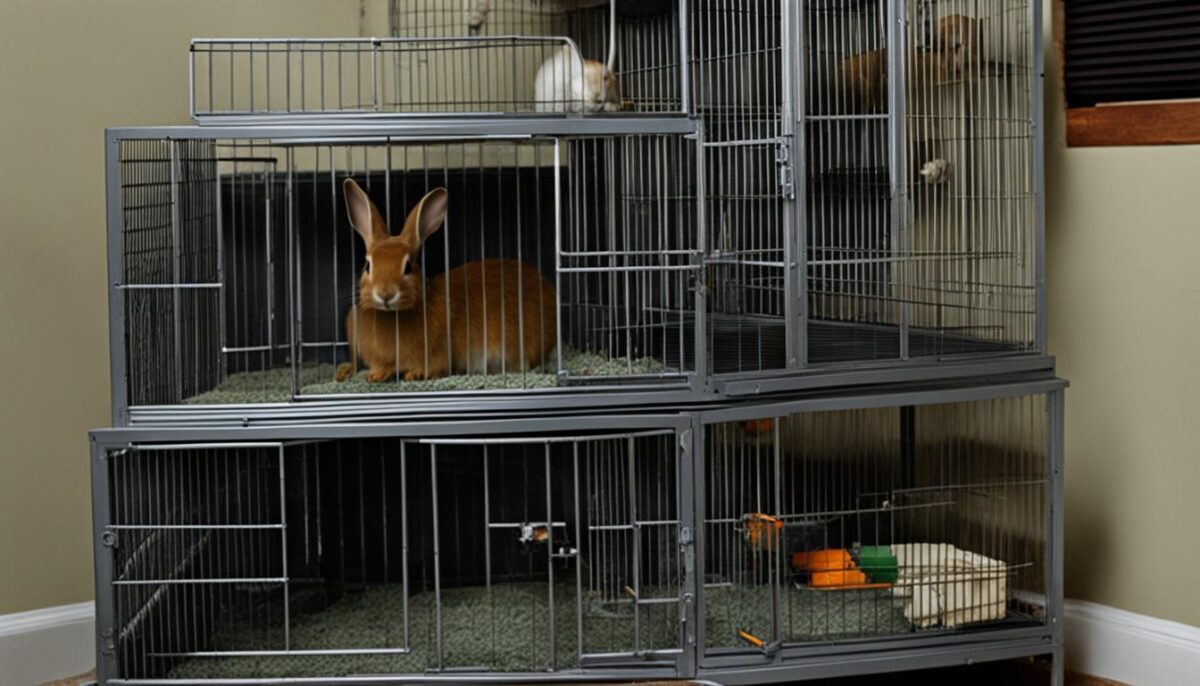
Rabbit Cage Plans and Assembly
When it comes to building a rabbit cage, following a set of plans can ensure that you create a sturdy and comfortable living space for your furry friends. Proper dimensions and overall structure are key factors in designing the ideal rabbit cage. Additionally, it’s important to consider the recommended wire size, which is typically 14-gauge.
The dimensions of the rabbit cage should be suitable for the size of the rabbit breed you are housing. This will provide enough space for the rabbit to move around comfortably. It’s crucial to prioritize the well-being and comfort of your rabbits by providing them with enough room to exercise and play.
The cage should have a door for easy access and appropriate ventilation. This will allow you to clean the cage, provide food and water, and interact with your rabbits easily. Good ventilation is essential to maintain a fresh and healthy environment inside the cage.
When it comes to assembling the rabbit cage, the process involves bending and securing the wire to form the sides and top. The wire mesh should be attached securely to ensure the cage is sturdy and safe. Additionally, the floor and roof mesh should be properly attached to provide a secure and comfortable substrate for the rabbits.
Installing a door is an important step in the assembly process. It should be well-designed and easily opened and closed to allow for convenient access to the cage. This will make it easier for you to clean the cage and attend to the needs of your rabbits.
| Assembly Steps: |
|---|
| 1. Measure and cut the wire mesh according to the dimensions of the cage. |
| 2. Bend and secure the wire mesh to create the sides and top of the cage. |
| 3. Attach the floor mesh to provide a comfortable substrate for the rabbits. |
| 4. Attach the roof mesh securely to provide proper protection. |
| 5. Install a door for easy access to the cage and proper ventilation. |
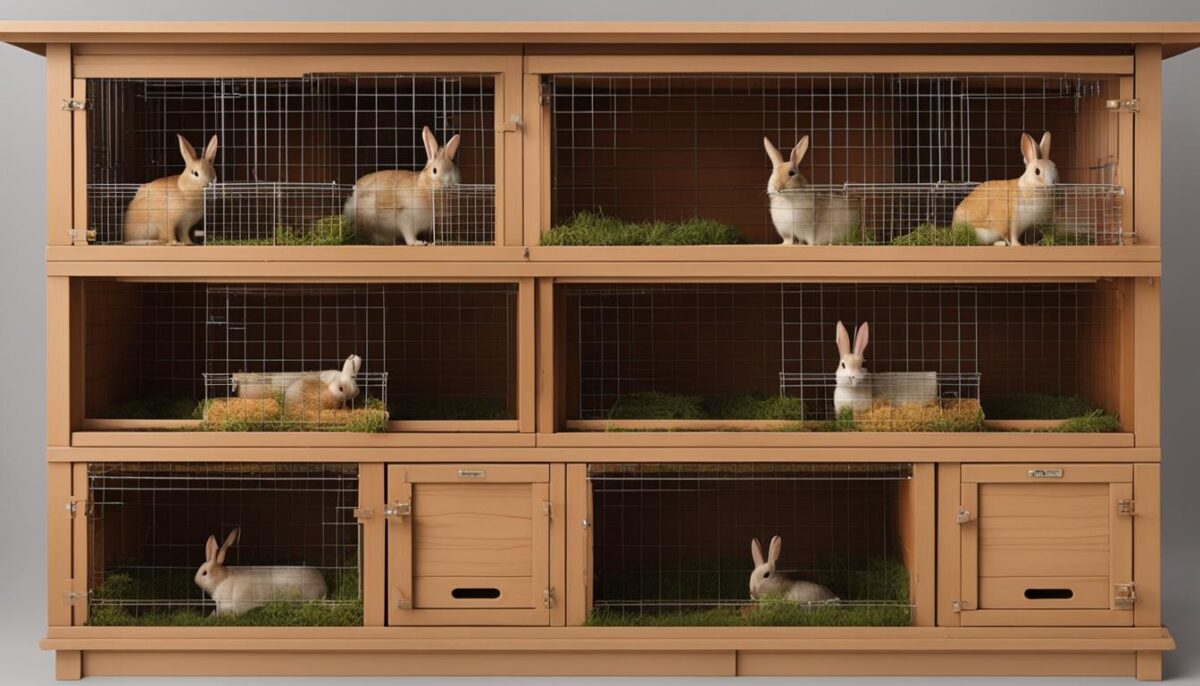
By following these plans and ensuring proper assembly, you can create a rabbit cage that meets the ideal size requirements for your furry companions. Providing them with a comfortable and secure living space is essential for their well-being and happiness.
Maintaining Rabbit Hutches
Regular maintenance is essential for keeping rabbit hutches in good condition. By properly caring for the cages, you can ensure the safety, health, and comfort of your rabbits. Here are some key aspects of hutch maintenance:
Cleaning and Waste Management
Regular cleaning of the rabbit cages is vital to prevent the buildup of waste and harmful bacteria. Remove any soiled bedding, droppings, and uneaten food on a daily basis. Scrub the cage surfaces using a pet-safe disinfectant and hot water. Ensure that the cage is dry before reintroducing the rabbits to prevent any potential health issues.
Bedding
Provide fresh and clean bedding material in the rabbit cages regularly. The bedding should be absorbent, provide cushioning, and help control odor. Suitable bedding options include hay, straw, shredded paper, or commercially available rabbit bedding products.
Ventilation
Proper ventilation is crucial for maintaining good air quality in the rabbit hutches. It helps remove stale air, excess moisture, and pollutants like ammonia. Ensure that the hutches have adequate airflow by providing ventilation holes or wire mesh panels. Regularly check and clean these openings to prevent blockages.
Inspections and Repairs
Regularly inspect the rabbit hutches for signs of wear, damage, or potential hazards. Check for loose wires, broken doors, or weak joints. Repair or replace any damaged parts promptly to maintain the safety of your rabbits. Additionally, make sure that the rabbits cannot escape or get injured by sharp edges or protruding nails.
“Regular maintenance is essential for keeping rabbit hutches in good condition.”
Health Check-ups
In addition to regular maintenance, it is crucial to schedule routine health check-ups for your rabbits. This ensures that any underlying health issues are identified and addressed promptly. Consult with a veterinarian experienced in rabbit care for vaccinations, parasite control, and overall health monitoring.
Rabbit Hutch Maintenance Checklist
| Aspect | Tasks |
|---|---|
| Cleaning | Remove waste, scrub cage surfaces, and dry thoroughly |
| Bedding | Provide fresh and clean bedding material |
| Ventilation | Ensure proper airflow and clean ventilation openings |
| Inspections | Regularly check for damage, repairs, and potential hazards |
| Health Check-ups | Schedule routine veterinary visits for health monitoring |
By following these maintenance practices, you can provide a clean, safe, and comfortable living environment for your rabbits.
Conclusion
Designing and maintaining the optimal rabbit cage or hutch size is crucial for the well-being and comfort of your rabbits. By considering factors such as space allowance, group size, and environmental conditions, you can create an ideal living space for these adorable pets.
Using a rabbit hutch size calculator, you can determine the ideal dimensions for your rabbit’s cage, ensuring they have enough room to move, play, and exhibit natural behaviors. Whether you choose a wire cage, outdoor hutch, or DIY cage rack, proper dimensions and construction materials are essential for the safety and comfort of your rabbits.
Regular maintenance is also key to keeping rabbit hutches in good condition. This includes cleaning the cages regularly, providing fresh bedding, and ensuring proper ventilation. By inspecting the cages regularly for any signs of wear or damage, you can address these issues promptly and ensure the safety of your rabbits.
Remember, creating an ideal living space for your rabbits not only enhances their well-being but also strengthens the bond between you and your furry companions. So, use the rabbit hutch size calculator, follow construction plans carefully, and provide regular maintenance to give your rabbits a safe and comfortable home they truly deserve.
FAQ
How do I determine the ideal size for a rabbit cage?
When determining the ideal size for a rabbit cage, it’s important to consider the space allowance and group size. Previous studies have shown that decreasing cage size can have limited effects on rabbit behavior, with sternal lying being the most consistently affected. However, providing rabbits with more space during grooming can have a positive impact on their welfare. Additionally, the use of wooden enrichment structures has been shown to decrease cage manipulation and interactions with other rabbits, improving overall welfare.
What factors should I consider in rabbit housing?
When choosing a housing option for rabbits, it’s essential to consider factors such as indoor vs. outdoor settings and the climate in which they will be housed. Rabbits are most comfortable between 50 and 69 degrees Fahrenheit but can tolerate temperatures well below freezing and above 100 degrees if the cages are optimized for optimal conditions. In hot climates, good airflow and shading are crucial to keep rabbits cool, while in cold climates, protection from harsh elements should be provided. Regardless of the type of housing, it is essential to provide a layer of protection from predators and the elements.
Are wire rabbit cages better than wooden ones?
Wire rabbit cages are recommended over wooden ones due to their durability and resistance to chewing. When constructing a wire cage, it’s important to use the appropriate gauge wire to prevent sores on the rabbit’s feet. The most common wire used is 14-gauge wire woven in a 1-by-2-inch mesh for the sides and tops of the cage. A smaller size mesh should be used for the floor to protect the rabbit’s feet. The cage should be assembled using J-clips or C-rings every few inches to ensure stability.
What should I consider when designing an outdoor hutch frame?
For outdoor rabbit housing, a hutch frame provides additional protection from the elements and predators. The frame can be constructed using 2-by-4 lumber and plywood. The hutch should be well-ventilated and well-lit, with removable sides for added ventilation in summer and protection in winter. Attention should be paid to design features such as access for cleaning, feeding, and watering, as well as adaptability to both indoor and outdoor use.
How can I create a DIY rabbit cage rack?
Making a rack to hold multiple rabbit cages can be an efficient use of space. PVC pipes are a cost-effective option for constructing the rack. The rack should be designed to accommodate the size of the cages and provide proper support. Using metal angles attached to the rack can allow for easy cleaning by allowing the dropping pans to slide out. It’s important to ensure the rack is stable and securely assembled to prevent any accidents.
How do I build a rabbit cage?
When building a rabbit cage, following a set of plans can be helpful to ensure proper dimensions and overall structure. In general, the recommended wire size is 14-gauge, and the dimensions should accommodate the size of the rabbit breed. The cage should have a door for easy access and appropriate ventilation. The assembly process involves bending and securing the wire, attaching the floor and roof mesh, and installing the door.
How do I maintain rabbit hutches?
Regular maintenance is essential for keeping rabbit hutches in good condition. This includes cleaning the cages regularly to prevent the buildup of waste and bacteria. Providing fresh bedding and ensuring proper ventilation are also crucial. Checking for any signs of wear or damage and repairing or replacing parts as needed is important for the safety and well-being of the rabbits. Regular inspections can help identify any potential issues and address them promptly.
Why is designing and maintaining the optimal rabbit cage or hutch size important?
Designing and maintaining the optimal rabbit cage or hutch size is crucial for the well-being and comfort of the rabbits. Taking into account factors such as space allowance, group size, and environmental conditions can help create an ideal living space for these animals. By following proper construction plans and regularly maintaining the cages, rabbit owners can ensure that their pets have a safe and comfortable home.


